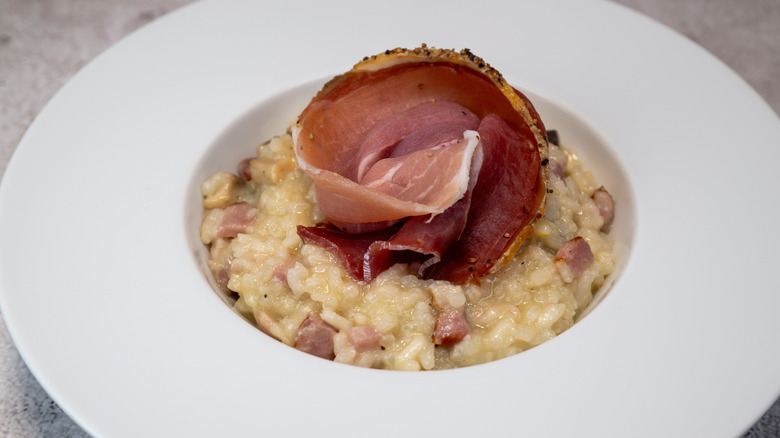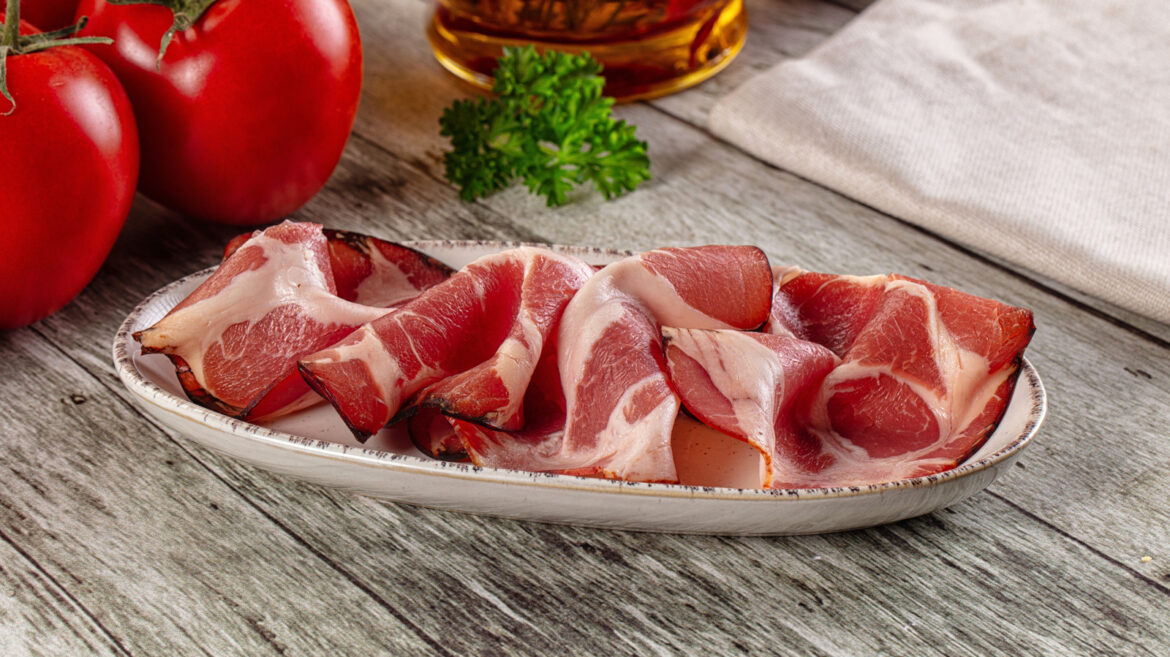
Andrey Starostin/Shutterstock
If you haven’t made capicola a regular feature of your shopping list, you’re missing out. This Italian deli meat is the lesser-known, underrated sibling to ham, prosciutto, and pepperoni. Also known as gabagool (a term that anyone who ever watched “The Sopranos” will be aware of), coppa, and capocollo, it’s made by curing a cut of pork that runs along the shoulder and neck of the pig in a mixture of wine, garlic, and spices. This mixture gives capicola a bold taste and a depth that some other deli meats can lack.
Capicola’s spicy, briny taste gives sandwiches a real burst of life, but its punchiness also makes it a natural fit for a variety of other dishes. It’s as good as a topping as it is as a filling, and it’s perfect for pizzas or for crowning risottos or pastas. Its complex flavor also makes it a great choice to pair with milder notes, and it really sings in chicken and egg dishes. Plus, you can use it to make meals that might be a little boring, like your daily salad, into something special. Let’s check out all of the ways this staple can be the star of the show.
Stuff it into chicken breasts

Andy Shell/Shutterstock
Not enough people are stuffing their chicken breasts, and we think that’s a crying shame. It may seem like a painstaking process to stuff chicken, but it’s really the work of moments: All you need to do is cut it open, insert your filling of choice, and then seal it, usually with a toothpick. The biggest decision you’ll likely face is to find a filling that pops without overwhelming the delicate flavor of your chicken — and that’s where capicola comes in. Capicola’s salty, spicy flavor contrasts the subtlety of chicken breast beautifully, and seasons it from within while remaining restrained enough not to dominate the whole dish.
Capicola’s texture also comes into play here. When it’s left poking out of the side of the chicken, it crisps up nicely, while the meat inside remains tender. This gives the dish a dual consistency and a dynamic mouthfeel. Remember, though, that it’s also a good idea to find another flavor that can contrast the salty, umami notes of the capicola. Cheese can be a good pairing, and a slice of provolone layered on top of the deli meat can give it a luscious creaminess.
Replace ham with capicola in Eggs Benedict

Thepalmer/Getty Images
This may be a controversial opinion, but we think that ham can get a little forgotten about in an Eggs Benedict. Most chefs spend so long perfecting the Hollandaise sauce and cooking the egg just right that when it comes to the meat, they grab whatever they’ve got in the fridge and toss it on without a second thought. Taking all that time to cook the perfect breakfast, and then using flabby, damp, cheap supermarket ham? There’s got to be a better way. Well, there is — and its name is capicola.
Capicola gives eggs Benedict a complex, spice-forward flavor that also has all of the meatiness that you’d expect from ham. It also firms up nicely when it’s pan-fried or grilled, so you can give your eggs Benedict a little more texture, but it also works fine straight out of the packaging. Capicola lends itself to more luxurious flavors, so it’s also an opportunity to make your Eggs Benedict even fancier. Before you add your egg on top, sprinkle the capicola with a little goat cheese, and then throw on some mushrooms sautéed in butter and garlic. We promise it’ll be the best breakfast of your life.
Use it as a pizza topping

cesarasf/Shutterstock
You can use any type of deli meat on a pizza, but we think that capicola is the one to beat. Capicola provides all of the meatiness that you’d expect from a deli ham, but it also has an aromatic, floral, and peppery quality that elevates any pizza. It feels classy, but also substantial and filling, and it develops a lovely crunch when it’s cooked at high temperatures. The red pepper flakes that are often in capicola give it a closeness to pepperoni, but it won’t be as fatty or greasy as salami can sometimes become. You can even use your meat on frozen pizza in a pinch, although we’d recommend not wasting your capicola on cheaper options.
Capicola is also very versatile, and while it can sometimes be the dominant flavor, it plays well with others. It’s particularly good with creamy notes, and buffalo mozzarella is a natural fit for this meat. Capicola also goes nicely with roasted vegetables, with the earthy flavors of vegetables like zucchini and yellow squash helping to stop the deli meat from being too forceful. It’s best not to crowd capicola, though: You want to give it space to breathe, and not muddy its flavor with too many other ingredients.
Add it to a risotto

FreeProd33/Shutterstock
If you want to make capicola sing, then combining it with creaminess is a great way to do it. However, that doesn’t always have to be through copious amounts of cheese. That’s why we love using it in risotto. Sure, risotto’s creaminess partly comes from the inclusion of Parmesan (although that’s not always an ingredient), but it’s also conjured by the starchiness of the rice. This starchiness works as a bed for capicola’s flavors to sit on, and they pull out a little bit of its intensity, without making it seem dull.
When using capicola in a risotto, we’d recommend doing so as a topping rather than as a central ingredient. You can certainly stir it into your rice mixture, but it can lose a little bit of its punchy flavor that way — as this is probably one of the more expensive ingredients you’re using, you want it to stand out, right? Instead, thinly slice your capicola and layer a few pieces on top of the risotto. Alternatively, you can cut it into tiny strips and pan-fry them until they curl up and develop a nice crunch. You can throw it on everything from a simple mushroom risotto to one flavored with pumpkin to a risotto perfumed with saffron.
Pile it onto a charcuterie board

Xan/Shutterstock
Deli meat is an essential component of most charcuterie boards, but it can be easy to stick with the staples that we all know and love, like salami and prosciutto. If you want to mix things up a little, but not stray too far away from the flavors everyone expects, then capicola is a great option. Capicola’s brininess and complex flavor stand out on a crowded charcuterie board, giving it a real presence. Despite this boldness, it’s surprisingly easy to pair it with loads of different types of wines, and it goes just as well with a full-bodied Chianti as it does with a zesty sparkling wine.
It also works well with the other classic elements of a charcuterie board, and tastes delicious with both creamy and sweet flavors. Cheese-wise, it’s good to go with a creamy, rich option like Brie or Cheddar. Its spicy, sodium-forward flavors also go well with sugary fruits like figs, and with briny olives. Just make sure that, as with all of your deli meats and cheeses, you’re serving it at room temperature and not straight out of the fridge. Be careful to avoid all of those other classic charcuterie board mistakes, too.
Bake capicola in pastries or tarts

Kabvisio/Getty Images
When you cook capicola, all of its flavors intensify, and it gains even more depth. However, if eaten on its own, this cooked deli meat can be a little too rich. That’s why it’s always a nice idea to pair it with something neutral, and pastry is the perfect counterpoint to this fatty, salty meat. Popping capicola into your pastries or tarts can imbue them with meaty flavor, while the pastry itself helps to balance the meat’s potency. Plus, it goes fantastically with many of the other classic pastry or tart fillings you’d normally use, like goat cheese or mozzarella and pesto.
While you can tuck capicola away inside pastry and leave it as a surprise for whoever’s biting into it, we prefer to leave it on display. That way, its deep red color creates visual appeal, and the exposed edges of the capicola become crunchy and slightly charred. Wrapping capicola into pinwheel tarts and baking them in muffin tins can be a great way to do this, and when cooked, you get an on-the-go breakfast, lunch, or snack.
Toss it into a salad

Clarkandcompany/Getty Images
Capicola is rich, and so it’s useful to think about ways to use it that balance it out with some lightness and freshness. Throwing it into a salad will introduce those qualities, while still allowing the capicola to stand out (and it’s a great way to use your leftover deli meat). Although it’s got a distinctive flavor, capicola is still versatile enough to be paired with loads of different salad ingredients. Having said this, we think it’s best not to stray too far away from its inherent flavor profile and go for options that mirror its Italian origins. The flavor notes of basil, olives, extra virgin olive oil, and red wine vinegar will all pair wonderfully with this meat.
When including capicola, you’ll also want the salad itself to feel special, so we hereby give you permission to skip the classic ingredients and go for something a little more exciting. Try making a spring salad with capicola, peas, microgreens, fresh herbs, and burrata. Alternatively, lean into the fact that it’s a deli meat staple, and go for a sub-inspired salad with other sliced meats, cheeses, and giardiniera. The world’s your oyster here, folks: Just treat it with the respect it deserves.
Use capicola in a cheesy pasta dish

Ezume Images/Shutterstock
Capicola and pasta are a match made in heaven — but it’s important to think about what kind of tastes you’re going for. Its flavor will be swallowed up by rich, intense, acidic tomato sauces, and even lighter ones can clash a little too much with its briny, spicy notes. Instead, this meat thrives when it’s used in creamier pasta dishes, and when incorporated into cheese-based pastas, it delivers a burst of salty umami.
Importantly, too, you should allow the capicola to be the stand-out flavor in cheesy pastas. If you’re including it in a four-cheese dish or one that’s already got the heavy notes of blue or goat cheese, it’ll get lost. Stick to using it in simpler dishes that have just one or two cheeses in them and nothing too bold, so that it can really shine. Perhaps our ultimate favorite way to use it is as a topping for mac and cheese, and crisping it in a pan before scattering the shards on top of a bowl of cheesy, gooey glory.
Add it to your homemade scones

from my point of view/Shutterstock
You know what’s better than a homemade scone? A homemade scone with capicola in it. This ingenious use of capicola gives your scones a meatiness and makes them more filling, and tucks all of the flavor inside each bite, so that you don’t have to worry about adding any toppings once they’re cooked. As a bonus, because scones are so robust and rustic, there’s really no way to get this wrong. Even if they’re a little lumpy, or your capicola is chopped a little roughly, they’ll still taste great and be a real crowdpleaser.
You can use capicola as the only addition to scones, or you can mix things up and make them even more interesting. Alongside your capicola, try tossing in some Parmesan, cubed fontina, and a sprinkle of fresh or dried oregano. You can also add thyme or dried parsley; just use what you have. Alternatively, you could do as Giada de Laurentiis does and create a sweet contrast in your scones by mixing your capicola with chopped dried fruit. De Laurentiis uses dried apricots, but you could also opt for dried peaches or even raisins.
Pop capicola into a quiche

Nata_vkusidey/Getty Images
Capicola and eggs work well together. The meat’s salty, spicy profile gives egg-based dishes a burst of flavor, and the eggs offset the capicola’s intensity. That makes it a lovely addition to foods like omelets and scrambled eggs, and can also be awesome when paired with a fried egg in a sandwich.
However, we prefer our egg dishes to be a little more hands-off, and so capicola quiche is the one for us. Not only does capicola spice up a quiche, but it also holds its own against the other ingredients you’ll likely be including. Plus, when arranged properly, it makes your quiche look so much more aesthetically pleasing. Roll it into curls and stud it on top of your quiche before baking, and it’ll come out of the oven looking almost like a floral arrangement.
When using capicola in a quiche, it’s good to think about how you can incorporate other ingredients that freshen things up. Opting for chopped vegetables can do this well, and using fresh or dried herbs can also create a sense of floral lightness. Make sure that you don’t season your quiche too heavily with salt or pepper, either: The capicola will bring a lot of sodium and spice to the table. You should also make sure you’re buying meat that isn’t highly processed, too, as those will likely be way more salty.


Dining and Cooking